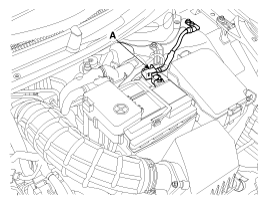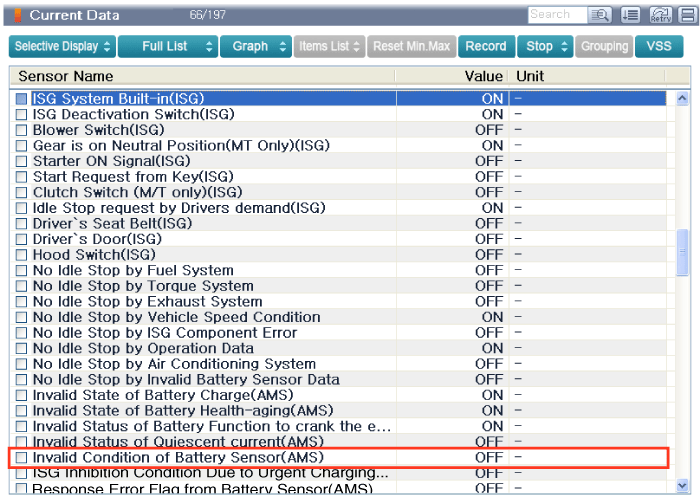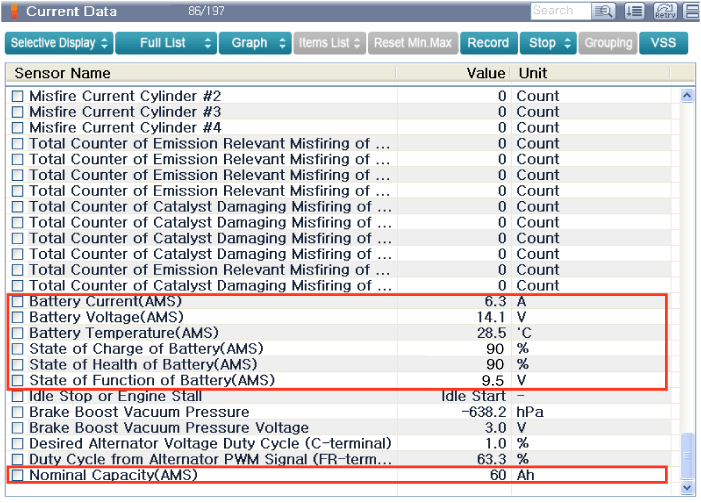Kia Cee'd: Charging System / Battery Sensor Repair procedures
| 1. |
Disconnect the battery negative (-) cable.
|
| 2. |
Disconnect the battery sensor connector (A).
|
| 3. |
Remove the battery negative (-) cable after removing the bolts.

|
| 1. |
Install in the reverse order of removal.
|
Battery sensor cable installation bolt: 10.8 ~ 13.7 N.m (1.1
~ 1.4 kgf.m, 8.0 ~10.1 lb-ft)
Battery (-) terminal l tightening nut: 3.9 ~ 5.9 N.m (0.4 ~
0.6 kgf.m, 2.9 ~ 4.3 lb-ft)
|
| •
|
After reconnecting the battery negative cable, AMS and
ISG function does not operates until the system is stabilized,
about 4 hours.
If disconnecting the negative (-) battery cable from
the battery during repair work for the vehicle equipped
with ISG function, Battery sensor recalibration procedure
should be performed after finishing the repair work.
(Refer to Battery Sensor Recalibration Procedure)
|
|
| •
|
For the vehicle equipped with a battery sensor, be careful
not to damage the battery sensor when the battery is
replaced or recharged.
|
| 1) |
When replacing the battery, it should be same one (type,
capacity and brand) that is originally installed on
your vehicle. If a battery of a different type is replaced,
the battery sensor may recognize the battery to be abnormal.
|
| 2) |
When installing the ground cable on the negative post
of battery, tighten the clamp with specified torque.
An excessive tightening torque can damage the PCB internal
circuit and the battery terminal .
|
| 3) |
When recharging the battery, ground the negative terminal
of the booster battery to the vehicle body.
|
|
|
| 1. |
Check for DTCs.
| •
|
If a DTC is present, perform troubleshooting in accordance
with the procedure for that DTC. (Refer to DTC guide)
|
|
|
| 2. |
Check if battery sensor status is normal on current data by using GDS.
If its value is ON, replace the battery sensor.
| – |
Invalid Conditon of Battery sensor (AMS) = OFF
|

| •
|
Battery sensor may operate abnormally if the parasitic
current is more than 100mA.
Therefore, if battery sensor signal error occurs, inspect
the vehicle parasitic current first before replacing
the battery sensor.
(Refer to Charging System - "Battery")
|
|
|
| Battery Sensor Recalibration Procedure
|
If disconnecting the negative (-) battery cable from the battery during repair
work for the vehicle equipped with Alternator Managing System(AMS) function,
Battery sensor recalibration procedure should be performed after finishing the
repair work.
| 1. |
Turn the Iginition switch ON and OFF.
|
| 2. |
Park the vehicle about 4 hours under below states.
| – |
Park the vehicle about 4 hours under below states.
|
| – |
Closing the hood, trunk, and all doors.
|
|
| 3. |
After 4 hours later, check whether the current datas are displayed normally
or not using GDS.
| – |
Nominal capacity(AMS) = 45Ah [For Non-ISG type]
|
| – |
Nominal capacity(AMS) = 60Ah [For ISG type or Russia region]
|
| – |
State of Charge of Battery(AMS) = (0~100%)
|
| – |
State of Health of Battery(AMS) = (0~100%)
|
|
| 4. |
After cranking the engine 2 times or more, check "State of Function
of Battery(AMS) =(0~12V)". [For ISG system only]

|
Description
Vehicles have many control units that use more electricity. These units control
their own system based on information from diverse sensors. It is important
to have a ...
Other information:
Kia Cee'd JD Owners Manual: Good braking practices
WARNING
Whenever you leave or park your
vehicle, always set the parking
brake as far as possible and fully
engage the vehicle's transaxle
into the P (Park) position. If the
parking brake is not fully
engaged, the vehicle may move
inadvertently and injure yourself
and othe ...
Kia Cee'd JD Owners Manual: Auto light/AFLS position
When the light switch is in the AUTO light
position, the taillights and headlights will
be turned ON or OFF automatically
depending on the amount of light outside
the vehicle.
If your vehicle is equipped with the adaptive
front lighting system (AFLS), it will
also operate when the hea ...
 Battery Sensor Description and operation
Battery Sensor Description and operation Starting System
Starting System




